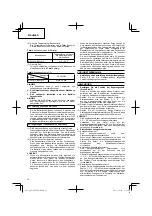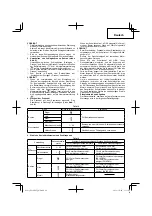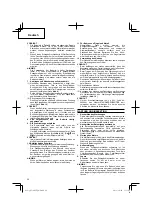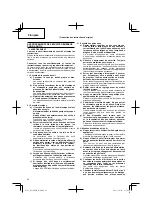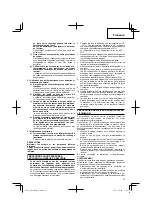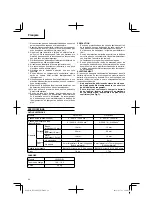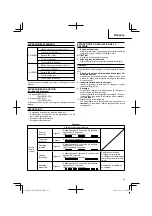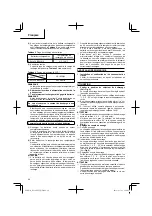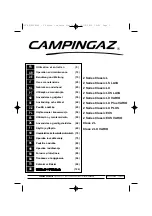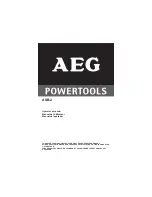
English
11
CAUTION
○
The
clutch
dial
cannot
be
set
between
the
numerals
“1,
3,
5
...
22”
or
the
dots.
○
Do
not
use
with
the
clutch
dial
numeral
between
“22”
and
the
line
at
the
middle
of
the
drill
mark.
Doing
so
may
cause
damage
(See
Fig.
6
).
2.
Tightening
torque
adjustment
(1)
Tightening
torque
Tightening
torque
should
correspond
in
its
intensity
to
the
screw
diameter.
When
too
strong
torque
is
used,
the
screw
head
may
be
broken
or
be
injured.
Be
sure
to
adjust
the
clutch
dial
position
according
to
the
screw
diameter.
(2)
Tightening
torque
indication
The
tightening
torque
di
ff
ers
depending
on
the
type
of
screw
and
the
material
being
tightened.
The
unit
indicates
the
tightening
torque
with
the
numbers
“1,
3,
5
...
22”
on
the
clutch
dial,
and
a
dots.
The
tightening
toque
at
position
“1”
is
the
weakest
and
the
torque
is
strongest
at
the
highest
number
(See
Fig.
5)
.
(3)
Adjusting
the
tightening
torque
Rotate
the
clutch
dial
and
line
up
the
numbers
“1,
3,
5
...
22”
on
the
clutch
dial,
or
the
dots,
with
the
triangle
mark
on
the
outer
body.
Adjust
the
clutch
dial
in
the
weak
or
the
strong
torque
direction
according
to
the
torque
you
need.
CAUTION
○
The
motor
rotation
may
be
locked
to
cease
while
the
unit
is
used
as
drill.
While
operating
the
impact
driver
drill,
take
care
not
to
lock
the
motor.
○
Too
long
hammering
may
cause
the
screw
broken
due
to
excessive
tightening.
3.
Rotation
to
Impact
changeover
(See
Fig.
5)
The
“Rotation
(Rotation
only)”
and
“Impact
(Impact
+
Rotation)”
can
be
switched
by
aligning
the
drill
mark
“
”
or
the
hammer
mark
“
”
with
the
triangle
mark
on
the
outer
body.
○
To
make
holes
in
the
metal,
wood
or
plastic,
switch
to
“Rotation
(Rotation
only)”.
○
To
make
holes
in
bricks
or
concrete
blocks,
switch
to
“Impact
(Impact
+
Rotation)”.
CAUTION
○
If
an
operation
which
is
normally
performed
at
the
“Rotation”
setting
is
performed
at
“Impact”
setting,
the
e
ff
ect
of
making
holes
does
not
only
increase
but
it
may
also
damage
the
bit
or
other
parts.
○
If
it
is
hard
to
turn
the
clutch
dial
to
hammer
mark
“
”
position,
turn
the
chuck
slightly
in
either
direction
and
then
turn
the
clutch
dial
to
hammer
mark
“
”
position
again.
4.
Change
rotation
speed
Operate
the
shift
knob
to
change
the
rotational
speed.
Move
the
shift
knob
in
the
direction
of
the
arrow
(See
Figs.
7
and
8
).
When
the
shift
knob
is
set
to
“LOW”,
the
drill
rotates
at
a
low
speed.
When
set
to
“HIGH”,
the
drill
rotates
at
a
high
speed.
CAUTION
○
When
changing
the
rotational
speed
with
the
shift
knob,
con
fi
rm
that
the
switch
is
o
ff
.
Changing
the
speed
while
the
motor
is
rotating
will
damage
the
gears.
○
When
setting
the
shift
knob
to
“HIGH”
(high
speed)
and
the
position
of
the
clutch
dial
is
between
“15”
and
“22”,
it
may
happen
that
the
clutch
does
not
engaged
and
that
the
motor
is
locked.
In
such
a
case,
please
set
the
shift
knob
to
“LOW”
(low
speed).
○
If
the
motor
is
locked,
immediately
turn
the
power
o
ff
.
If
the
motor
is
locked
for
a
while,
the
motor
or
battery
may
be
burnt.
○
To
extend
the
lifetime,
the
lithium-ion
battery
equips
with
the
protection
function
to
stop
the
output.Therefore,
if
the
tool
is
overloaded,
the
motor
may
stop.
However,
this
is
not
the
trouble
but
the
result
of
protection
function.
In
this
case,
release
the
switch
of
tool
and
eliminate
the
causes
of
overloading.
5.
The
scope
and
suggestions
for
uses
The
usable
scope
for
various
types
of
work
based
on
the
mechanical
structure
of
this
unit
is
shown
in
Table
4
.
Table
4
Work
Clutch
dial
position
Suggestions
Drilling
Brick
Use
for
drilling
purpose.
Wood
Steel
Aluminum
Driving
Machine
screw
1
–
22
Use
the
bit
or
socket
matching
the
screw
diameter.
Wood
screw
1
–
Use
after
drilling
a
pilot
hole.
000Book̲DV14DSFL̲WE.indb 11
000Book̲DV14DSFL̲WE.indb 11
2011/03/23 12:00:47
2011/03/23 12:00:47


















